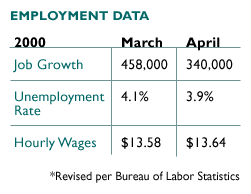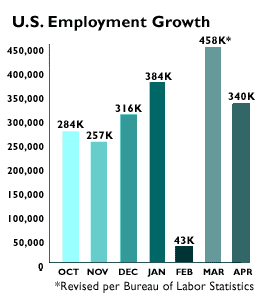NEW YORK (CNNfn) - The U.S. unemployment rate tumbled to a 30-year low of 3.9 percent in April, the government reported Friday, as worker-starved companies raised wages and went on a hiring spree that created 340,000 new jobs.
But the good news for workers on Main Street sparked fears on Wall Street, where economists fret the Federal Reserve will aggressively raise interest rates to rein in growth and pre-empt rising inflation.
"The Fed is justified in being aggressive," Anthony Chan, chief economist at Banc One Securities, told CNNfn's Before Hours. "We're in uncharted waters here."
A sizzling economy in its record ninth year of expansion added 340,000 jobs outside the farm sector last month, the Labor Department said. That's well above Wall Street expectations of 325,000, but below the upwardly revised 458,000 the month before.
Average hourly earnings jumped 6 cents an hour, or 0.4 percent, to $13.64, following a similar gain in March. That's higher than forecasts and suggests companies faced with a worker shortage are increasing compensation to retain them.
 But the most dramatic number is the unemployment rate. The 3.9 percent rate is the lowest since January 1970, when Richard Nixon was president. But the most dramatic number is the unemployment rate. The 3.9 percent rate is the lowest since January 1970, when Richard Nixon was president.
The milestone comes amid an ever-tightening job market where few people, it seems, go wanting for work.
"I think this is a very strong report," Alexis Herman, Labor Department secretary told CNNfn's market coverage. "More Americans are working than ever before." (514K WAV) (514K AIFF)
The Fed ahead
But economists said this new evidence of labor market tightness gives Federal Reserve inflation fighters reason to aggressively raise interest rates.
"Both the unemployment rate and wages were stronger than consensus and they clearly make it very difficult for the Fed not to raise rates by [a half percentage point]," said Ian Shepherdson, chief U.S. economist at High Frequency Economics.
Still, the markets took the data in stride. Stocks, which fell in the days ahead of the release, rose as Wall Street concluded that higher interests rate are already priced into equity prices. And Treasury securities, ever sensitive to higher inflation, came off their worst levels of the morning.
The markets harbor no doubts of the Fed's concerns over labor market tightness. On Wednesday, the Federal Reserve in its periodic assessment of the economy warned that a lack of available workers is fueling pressure on companies to pay higher wages.
The fine print
The week's most closely watched economic indicator showed seasonal aberrations. Some 73,000 of the 340,000 jobs were temporary ones created by Census Bureau to take the 2000 population tally.
Still, increases spanned the economy. The services industry hired 121,000 workers, while retailers added 119,000. Construction employment fell by 55,000 workers in April.
At the same time, the unemployment rate for blacks and Hispanics fell to record lows. That's 5.4 percent for Hispanics and 7.2 percent for blacks.
"These figures show that our prosperity is propelling more and more Americans into the mainstream," Labor Secretary Herman said in a conference call.
Still, not everyone is hiring. In fact, Xerox Corp. on March 31 announced that it is cutting 5,200 jobs, or 5 percent of its work force.
The market effect
The Federal Reserve, the U.S. central bank, has raised interest rates five times since last June in a bid to slow growth and stem the rise in prices.
Friday's data means their job is far from done.

"Growth is very strong and our feeling is the Fed is going to have to go 50 basis points," Byan Piskorowski, market analyst at Prudential Securities, told CNNfn's market coverage. "Our economy is steaming along and that has the Fed worried."
Tighter credit, by raising borrowing costs, can crimp corporate profits, a development that's bad for stocks. The Fed's rate hikes, which have brought its benchmark lending rate to 6 percent, may already be having that effect.
Both the Dow Jones industrial average and the Nasdaq composite index are down year to date. 
|

